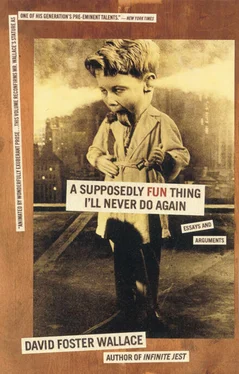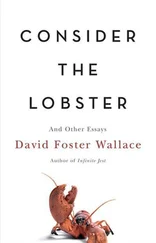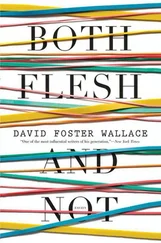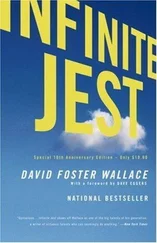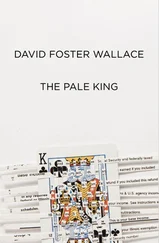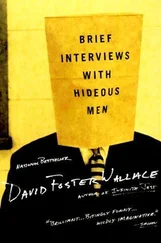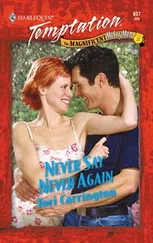Agassi, who is 25 (and of whom you have heard and then some), is kind of Michael Joyce’s hero. Just last week, at the Legg Mason Tennis Classic in Washington D.C., in wet-mitten heat that had players vomiting on-court and defaulting all over the place, Agassi beat Joyce in the third round of the main draw, 6–2 6–2. Every once in a while now during this Qualie match Joyce will look over at his coach next to me in the player-guest section of the Grandstand and grin and say something like “Agassi’d have killed me on that shot.” Joyce’s coach will adjust the set of his sunglasses and say nothing — coaches are forbidden to say anything to their players during a match. Joyce’s coach, Sam Aparicio, 35a protégé of Pancho Gonzalez, is based in Las Vegas, which is also Agassi’s home town, and Joyce has several times been flown to Las Vegas at Agassi’s request to practice with him, and is apparently regarded by Agassi as a friend and peer — these are facts Michael Joyce will mention with as much pride as he evinces in speaking of victories and world ranking.
There are big differences between Agassi’s and Joyce’s games, though. Though Joyce and Agassi both use the Western forehand grip and two-handed backhand that are distinctive of topspinners, Joyce’s ground-strokes are very “flat”—i.e. spinless, passing low over the net, driven rather than brushed — because the actual motion of his strokes is so levelly horizontal. Joyce’s balls actually look more like Jimmy Connors’s balls than like Agassi’s. 36Some of Joyce’s groundstrokes look like knuckleballs going over the net, and you can actually see the ball’s seams just hanging there, not spinning. Joyce also has a hitch in his backhand that makes it look stiff and slightly awkward, though his pace and placement are lethal off that side; Agassi’s own backhand is flowing and hitchless. 37And while Joyce is far from slow, he lacks Agassi’s otherworldly foot-speed. Agassi is every bit as fast as Michael Chang, and watch A.A. on TV sometime as he’s walking between points: he takes these tiny, violently pigeon-toed steps, the stride of a man whose feet weigh basically nothing.
Michael Joyce also — in his own coach’s opinion — doesn’t “see” the ball in the same magical way that Andre Agassi does, and so Joyce can’t take the ball as early or generate quite the same amount of pace off his groundstrokes. This business of “seeing” is important enough to explain. Except for the serve, power in tennis is a matter not of strength but of timing. This is one reason why so few top tennis players are muscular. 38Any normal adult male can hit a tennis ball with pro pace; the trick is being able to hit the ball both hard and accurately. If you can get your body in just the right position and time your stroke so you hit the ball in just the right spot — waist-level, just slightly out in front of you, with your weight moving from your back leg to your front leg as you make contact — you can both cream the ball and direct it. And since “… just the right…” is a matter of millimeters and microseconds, a certain kind of vision is crucial. 39Agassi’s vision is literally one in a billion, and it allows him to hit his groundstrokes as hard as he can just about every time. Joyce, whose hand-eye coordination is superlative, in the top 1 % of all athletes everywhere (he’s been exhaustively tested), still has to take some incremental bit of steam off most of his groundstrokes if he wants to direct them.
I submit that tennis is the most beautiful sport there is, 40and also the most demanding. It requires body control, hand-eye coordination, quickness, flat-out speed, endurance, and that strange mix of caution and abandon we call courage. It also requires smarts. Just one single shot in one exchange in one point of a high-level match is a nightmare of mechanical variables. Given a net that’s three feet high (at the center) and two players in (unrealistically) a fixed position, the efficacy of one single shot is determined by its angle, depth, pace, and spin. And each of these determinants is itself determined by still other variables — for example, a shot’s depth is determined by the height at which the ball passes over the net combined with some integrated function of pace and spin, with the ball’s height over the net itself determined by the player’s body position, grip on the racquet, degree of backswing, angle of racquet face, and the 3-D coordinates through which the racquet face moves during that interval in which the ball is actually on the strings. The tree of variables and determinants branches out, on and on, and then on even farther when the opponent’s own positions and predilections and the ballistic features of the ball he’s sent you to hit are factored in. 41No CPU yet existent could compute the expansion of variables for even a single exchange — smoke would come out of the mainframe. The sort of thinking involved is the sort that can be done only by a living and highly conscious entity, and then only un consciously, i.e. by combining talent with repetition to such an extent that the variables are combined and controlled without conscious thought. In other words, serious tennis is a kind of art.
If you’ve played tennis at least a little, you probably think you have some idea of how hard a game it is to play really well. I submit to you that you really have no idea at all. I know I didn’t. And television doesn’t really allow us to appreciate what real top-level players can do — how hard they’re actually hitting the ball, and with what control and tactical imagination and artistry. I got to watch Michael Joyce practice several times, right up close, like six feet and a chain-link fence away. This is a man who, at full run, can hit a fast-moving tennis ball into a one-foot-square area 78 feet away over a yard-high net, hard. He can do this something over 90 % of the time. And this is the world’s 79th-best player, one who has to play the Montreal Qualies.
It’s not just the athletic artistry that compels interest in tennis at the professional level. It’s also what this level requires — what it’s taken for the l00th-ranked player in the world to get there, what it takes to stay, what it would take to rise even higher against other men who’ve paid the same price he’s paid.
Bismarck’s epigram about diplomacy and sausage applies also to the way we Americans seem to feel about professional athletes. We revere athletic excellence, competitive success. And it’s more than attention we pay; we vote with our wallets. We’ll spend large sums to watch a truly great athlete; we’ll reward him with celebrity and adulation and will even go so far as to buy products and services he endorses.
But we prefer not to countenance the kinds of sacrifices the professional-grade athlete has made to get so good at one particular thing. Oh, we’ll pay lip service to these sacrifices — we’ll invoke lush clichés about the lonely heroism of Olympic athletes, the pain and analgesia of football, the early rising and hours of practice and restricted diets, the privations, the prefight celibacy, etc. But the actual facts of the sacrifices repel us when we see them: basketball geniuses who cannot read, sprinters who dope themselves, defensive tackles who shoot up bovine hormones until they collapse or explode. We prefer not to consider the shockingly vapid and primitive comments uttered by athletes in postcontest interviews, or to imagine what impoverishments in one’s mental life would allow people actually to think in the simplistic way great athletes seem to think. Note the way “up-close and personal profiles” of professional athletes strain so hard to find evidence of a rounded human life — outside interests and activities, charities, values beyond the sport. We ignore what’s obvious, that most of this straining is farce. It’s farce because the realities of top-level athletics today require an early and total commitment to one pursuit. An almost ascetic focus. 42A sub-sumption of almost all other features of human life to their one chosen talent and pursuit. A consent to live in a world that, like a child’s world, is very serious and very small.
Читать дальше
